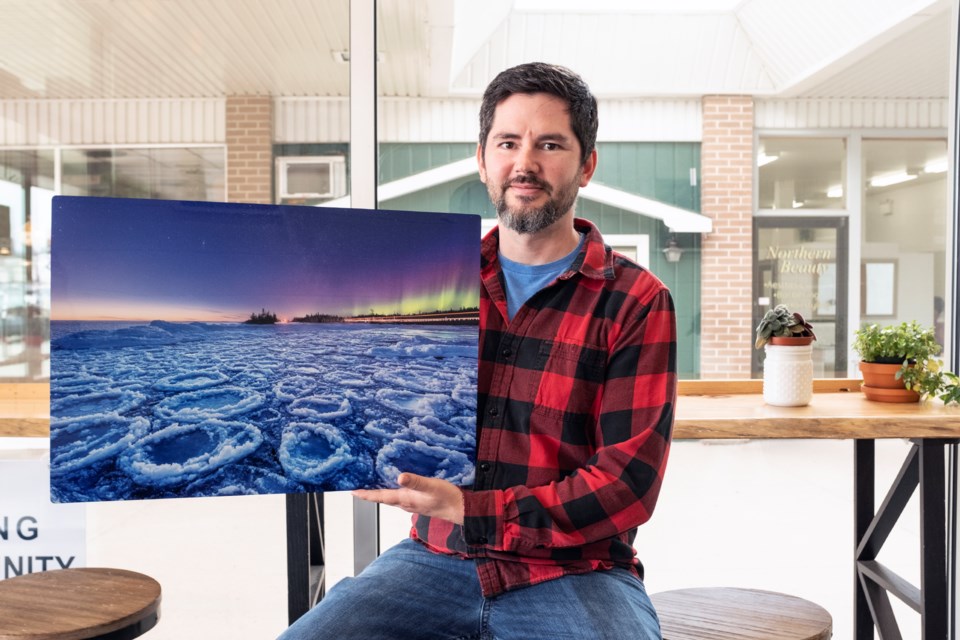In a cycle that peaks every 11 years, Mother Nature is preparing to put on an especially dazzling show of Northern Lights. And when it happens, local visual artist Jeff Dixon plans to be there with his camera.
Dixon has been photographing the Aurora Borealis, more commonly known as the Northern Lights, for about 20 years. The first time was in the early 2000s when they appeared while he was camping.
Consistent results in those early days were more difficult to achieve because Dixon was still learning and using a film camera, which doesn't allow the user to see results right away.
“In 2008 I bought my first digital camera and really started exploring and doing the nighttime photography,” he said.
From there, Dixon educated himself more about the phenomenon, how to predict when it will appear and what photographic equipment is needed to capture it.
A tripod is essential, said Dixon, because long exposures are often needed, with the camera's shutter open for 30 seconds or more. That allows the camera to collect more light and enhances what can be seen by the naked eye.
“You can’t see what your camera sees, it’s just not possible," said Dixon. "We see and process light in a split second and our irises are only so big, so we can’t absorb light like a camera can."
Camera technology has only improved the images that can be achieved, and Dixon said he has even seen some modern phones starting to be able to capture decent results. As the technology improves, he said interest in shooting the Northern Lights has also increased.
“Even a $500 entry-level SLR now will capture pretty good Northern Lights, where even a few years ago that wasn’t something you would expect from them," he said.
He said people are sometimes disappointed when the display doesn't look as brilliant in person as it can in photographs.
“Mostly it’s just lights and darks you see dancing, occasionally you will see the greens and only once have I seen reds with my eye. It was 2014 and it was really intense. It was really awesome,” said Dixon.
Every 11 years, the sun reaches what is referred to as Solar Maximum — the part of its regular cycle that typically produces the most sunspots and, in response, creates more vivid displays of Northern Lights here on Earth.
“What happens with the Aurora Borealis is a direct result of what happens on the sun, so understanding what is happening on the sun is the predictor," he said.
The Solar Maximum is expected to build over about the next two years.
Dixon mostly uses the data on a web site called SpaceWeather.com to predict if a light show is in the forecast, but it requires a bit of knowledge on how to read it. For beginners, he recommends free phone apps like AuroraNow, which can actually send alerts if the Aurora Borealis is expected to make an appearance.
“If they are predicting a 50 per cent chance — which is really good for Northern Lights — there’s still a 50 per cent chance you won’t see them," said Dixon. “My biggest advice is to not be discouraged, because if you go and don’t see anything you can’t give up. You have to try again because it is a game of chances."
Dixon said people don't need to go far from Sault Ste. Marie to see the Northern Lights. Haviland Bay or Harmony Bay are his go-to recommendations for beginners.
“I always tell people an open view looking north, preferably with a lake, with low trees or anything that will obstruct the horizon," said Dixon.
Open water also has the added benefit in photos of reflecting the lights, which is one reason why so many of his photos are created overlooking lakes.
He prefers driving north as opposed to going east because the light pollution from the city can interfere with views of the Northern Lights.
DIxon sometimes shoots with other people, but often drives out on his own at night to capture the light show. He recommends beginners go with a partner if they are not comfortable being alone at night in the wilderness.
“There’s something good for the soul — just being by yourself at night,” he said.
Dixon has a number of photography shows and will be selling prints every Saturday at Mill Market starting on May 27.
He will also start offering workshops in the near future, with details to come via his website.
His upcoming shows include:
- Summer market (Rib Fest) at the Mindemoya Arena in Manitoulin Island, June 30 and July 1
- Hilton Beach st Joseph Island, Art on the Dock, July 16th
- Richards Landing, Harvest of Artists, St Joseph Island Township Centennial Grounds, August 26th
- Sylvan Circle Tour, September 16th
